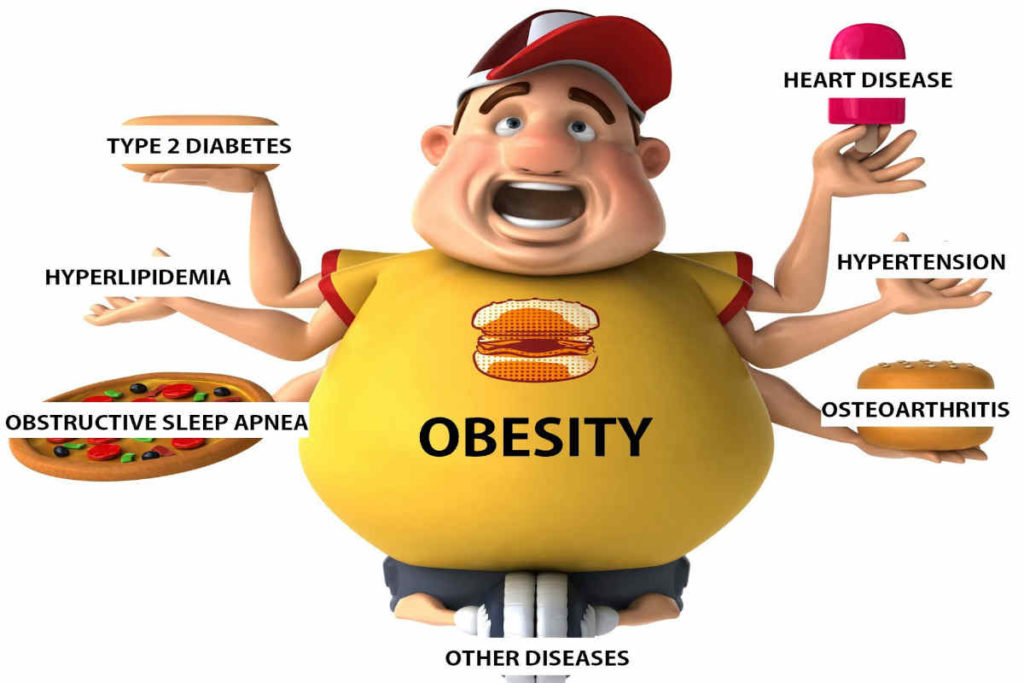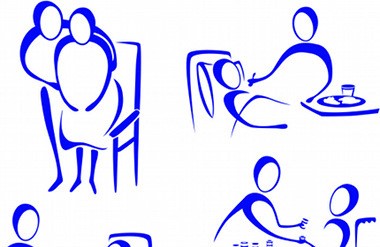Obesity

Obesity is a multifaceted health disorder that affects both adults and children. Being obese not only affects the overall persona of an individual but also increases the risk for many health concerns. An obese person is at a higher risk of developing health conditions like diabetes, heart disease, stroke, arthritis, breathing problems, and some cancers.
Statistics have revealed that obesity is a major factor contributing factor for metabolic syndrome and type 2 diabetes mellitus (T2DM) among Asian Indians. Various factors contribute towards making an individual obese. Some major factors which contribute towards obesity are environment, family history and genetics, metabolism or the way your body converts food and oxygen into energy, and individual’s lifestyle. Besides these factors certain medical conditions also leads to obesity. Scientists are also trying to understand that some chemicals in the environment may be playing in the growing obesity problem.
Recent guidelines have revealed that 10-15% of Indian population would fall under the obese category and would need appropriate management. Purpose of these guidelines on countrywide basis projects an alarming situation of T2DM and cardiovascular disease.
Some startling facts about obesity:
- According to a recent survey conducted worldwide: India has second highest obese children in world.
- Followed by China India ranks second in childhood obesity with the incidence of China with 15.3 million and India with 14.4 million.
- According to National Family Health Survey in 2018 –In past one decade the number of obese people has doubled.
- According to a latest publication in a medical journal-“The Lancet” –Currently there are 30 million obese Indians and by 2025, this number is expected to pass 70 million.
- Did you know lack of sleep increases the chances of obesity- If you do not sleep enough you produce Ghrelin, a hormone that increases your appetite and hence adds extra pounds to your body.
- India the third most obese country in the world – According to a study published in a medical Journal Lancet- India is just behind US and China in this global hazard list of top 10 countries with highest number of obese people.
- Latest Survey reveals that technology addiction too is adding to obesity amongst young adults and children in India. Television, computers and video games at the cost of sports and physical activity, causing sedentary life style are prime causes of obesity among young ones.
- Surprisingly but true-Globally, Obesity causes more deaths than malnutrition -Worldwide, obesity is one of the top five leading causes of death. It results in greater than 2.8 million deaths every year.
What is the need for new guidelines for obesity among Asian Indians?
New guidelines have been proposed in view of alarming situation of obesity among Indians. These guidelines have been prepared by 100 medical experts all across the country hailing from the backgrounds of internal medicine, diabetes, metabolism, endocrinology, nutrition, cardiology, exercise physiology, sports medicine, bariatric surgery and representing reputed medical institutions, hospitals, government funded research institutions. The very need for these guidelines has been enumerated below:
- In view of increasing trend in frequency of obesity and related metabolic diseases, there is dire need of effective interventions in obesity
- As Asian Indians manifest a higher risk of cardiovascular risk factors and T2DM at lower levels of obesity, the appropriate obesity diagnosis should be based on lower level of weight for height than in non-Asian Indian populations.
- Current obesity international guidelines are not appropriate for Asian Indians. Moreover, WHO has authorized local governments and scientists to decide on the localized guidelines for the Asian Indians.
- If appropriate diet, exercise, drug and surgery are employed at lower levels of obesity, nearly 15% of the adult population of India (nearly 5-7 crore people) will show improvement in obesity coupled with reduced risk of diabetes and cardiovascular disease.
How obesity is diagnosed among Indians?
Three parameters which are used to measure obesity are body mass index BMI, waist circumference WC and waist-to-hip circumference ratio (WHR). The most accepted method to define thinness and fatness is BMI, a ratio of weight in kilograms divided by height in meters squared (kg/m2).
What are the cut offs for BMI and WC in defining obesity among Asian Indians?
After a major consensus among scientists below table has been prepared to depict the obesity among Asian Indians:
| Classification | BMI(kg/m2) | |
| Principal cut-off points | Cut-off pointsfor Asians | |
| Normal range | 18.5 – 24.9 | 18.5 – 22.9 |
| 23.0 – 24.9 | ||
| Pre-obese | 25.0 – 29.9 | 25.0 – 27.4 |
| 27.5 – 29.9 | ||
| Obese (Class I) | 30.0 – 34.9 | 30.0 – 32.4 |
| 32.5 – 34.9 | ||
| Obese (Class II) | 35.0 – 39.9 | 35.0 – 37.4 |
| 37.5 – 39.9 | ||
| Obese (class III) | ≥40.0 | ≥40.0 |
Source: Adapted from WHO 2004 and recent guidlines
What does recent guidelines say about WC and WHR cut offs in defining obesity?
Research has revealed that abdominal obesity is associated with higher risk of diabetes and cardiovascular disease when compared with generalized obesity. Cardiovascular disease is associated with increased amounts of excess abdominal adipose tissue, both intra-abdominal adipose tissue (IAT) and subcutaneous adipose tissue (SCAT). In view of this a joint discussion and consensus among scientists concluded the WC cut off among Asian Indians as defined below:
- Action level 1: Men: 78 cm, women: 72 cm. Any person with WC more than these levels should refrain from gaining weight and adopt healthy lifestyle to prevent the risk of any of the cardiovascular risk factor.
- Action level 2: Men: 90 cm, women: 80 cm. Individuals with WC above this should seek medical help so that obesity-related risk factors could be diagnosed and handled.
What are the causes of obesity?
Obesity could be genetic, behavioral and can also result due to the hormonal changes in the body. Obesity occurs when you take in more calories than you burn through exercise and normal daily activities. Your body stores these excess calories as fat. Some medical conditions also result in obesity such as Prader-Willi syndrome, Cushing’s syndrome, and other diseases and conditions. The main reasons for obesity are either sedentary lifestyle or eating unhealthy such as junk foods at wrong intervals.
What are the risk factors that can contribute to obesity?
Obesity usually results from a combination factors, including:
- Genetics. Genetics may also play a role in how efficiently your body converts food into energy and how your body burns calories during exercises.
- Family lifestyle. Family members share common eating habits. Obesity runs mostly in families as common eating habits of eating fatty foods contribute to obesity.
- Inactivity. If you are inactive throughout the day, you are more prone towards obesity. Certain diseases like arthritis also result in decreased mobility and hence inactivity
- Diet. A diet rich in fats and less minerals and vitamins can result in obesity
- Medical problems. In some people, obesity can be traced to a medical conditions like Prader-Willi syndrome, Cushing’s syndrome and other conditions. Medical problems, such as arthritis, also can lead to decreased activity, which may result in weight gain.
- Medications. Some medicines such as antidepressants, anti-seizure medications, diabetes medications, antipsychotic medications, steroids and beta blockers also make the person obese
- Social and economic issues. Research has shown that weight gain can be linked to social and economic factors.
- Age. As we grow in age a decreased physical activity and lower metabolic rate can result in obesity.
- Sleep deprivation. Not getting enough sleep or getting too much sleep can cause changes in hormones which may lead to an increase in appetite. You may also crave foods high in calories and carbohydrates, which can contribute to weight gain.
What are the complications associated with obesity?
A number of health problems arise if you are obese. Some of the diseases which you may encounter include:
- High triglycerides and low high-density lipoprotein (HDL) cholesterol
- Type 2 diabetes
- High blood pressure
- Heart disease
- Stroke
- Cancer
- Breathing disorders, including sleep apnea, a potentially serious sleep disorder in which breathing repeatedly stops and starts
- Gallbladder disease
- Gynecological issues such as infertility and irregular periods
- Erectile dysfunction and sexual health issues
Quality of life-If you are obese you are most likely to suffer from other issues, which can severely affect the quality of life. Some common problems which arise due to obesity include depression, disability, sexual problems, shame and guilt, social isolation, and poor performance at workplace
How can you prevent obesity?
You can take some below-mentioned steps to prevent obesity:
- Exercise regularly. Exercises such a fast walking and swimming for 150 to 300 minutes in a week can prevent obesity
- Eat healthily. Eat low-calorie, nutrient-dense foods, such as fruits, vegetables, and whole grains. Refrain from foods which are high in fat content.
- Monitor your weight regularly. Keep an eye on your weight at regular intervals as it can help you to assess your weight regularly
What are the recent guidelines on physical activity?
According to joint decision among scientist below is the list of guidelines about physical activity in combating obesity and associated health concerns:
- Physical inactivity should be refrained as much as possible
- Pro active medical consultation is recommended for those with chronic conditions or those who are symptomatic
- Inactive people must switch on to physical activity
- Brisk walking (walking at an intensity wherein an individual finds speaking difficult but not impossible) should be encouraged
- On an average a total of 60 minutes of physical activity like aerobic activity, work-related activity and muscle strengthening activity should be included daily
- For additional and greater health benefits, adults can increase their aerobic physical activity to 300 minutes (5 hours) a week of moderate-intensity, or 150 minutes a week of vigorous-intensity aerobic physical activity
- Yoga should be included; however, more research is needed to fully explore its benefits
- Children should undertake at least 60 min of outdoor physical activity. Screen time (television/computers) should be less than 2 hrs a day.
What is the treatment of obesity?
The treatment of obesity includes a combination treatment from a dietitian, behavior counselor or an obesity specialist. Recent guidelines suggest identifying and treating the underlying cause of obesity, lifestyle modification, pharmacological treatment like ant-obesity drugs along with lifestyle modification, and if needed surgical treatment is advisable in treating obesity.
Scientists have concluded that anti-obesity drugs should be prescribed in combination with dietary and lifestyle changes as a part of comprehensive weight loss program. Also, drug treatment should be monitored on an ongoing basis for efficacy as well as safety. In general, anti-obesity drugs should be administered for BMI above 27 kg/m2 or a BMI above 25 kg/m2
Anti-obesity drugs which are recommended to treat obesity are sibutramine, orlistat should be used as a second line therapy. At times metformin and exenatide can be used under special clinical conditions.
What is the surgical treatment for obesity?
Over the past few years bariatric surgery has come out as an option for obesity reduction. Bariatric surgery involves an alteration in the digestive system by reducing the gastric volume or by changing the path of food bolus which can lead to malabsorption. According to current international guidelines below are the guidelines for bariatric surgery:
- Current International Guidelines: BMI above 35 kg/m2, or BMI above 40 kg/m2.
- For Asian Indians: BMI above 32.5 kg/m2
Various surgical options are available under the umbrella of surgery which includes:
- Restrictive Procedures like Adjustable gastric banding (LAGB) & sleeve gastrectomy
- Combined Procedures like Roux-en-Y Gastric or Bypass (RYGBP)
- Malabsorptive Procedures like Bilio-pancreatic diversions (BPD)
- Experimental Procedures like ileal interposition
- Duodeno-jejunal bypass and other implantable pulse generators.
Pros and Cons are associated with above mentioned procedures; however, it is upon the physician to decide that which surgical treatment is best suited for the particular patient.
Having a positive attitude towards weight loss and employing various changes in lifestyle such as exercising and eating a well-balanced diet can help you to lose weight. Nevertheless, obesity remains a rampant problem even in developing nation like India. Appropriate interventions are required in a timely manner to combat this problem to prevent other major health concerns.
Obesity Support Groups
These inspiring stories of those who have overcome Diabetes will keep you motivated













